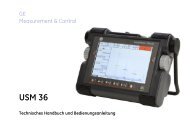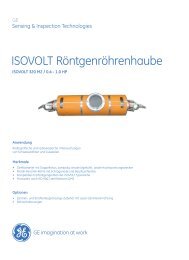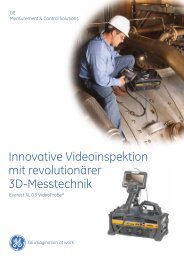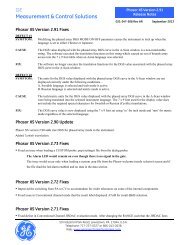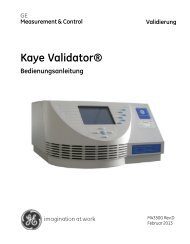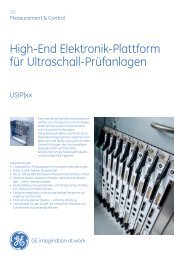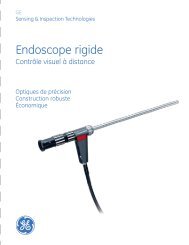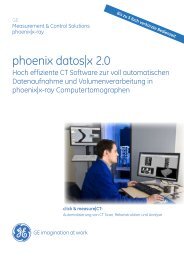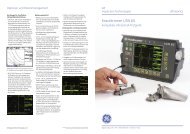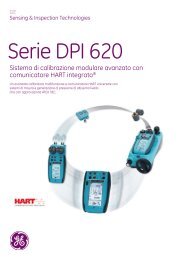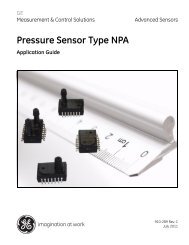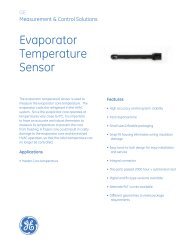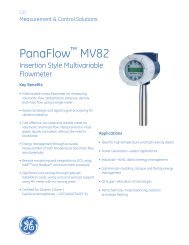Goes - GE Measurement & Control
Goes - GE Measurement & Control
Goes - GE Measurement & Control
You also want an ePaper? Increase the reach of your titles
YUMPU automatically turns print PDFs into web optimized ePapers that Google loves.
I<br />
<strong>Goes</strong><br />
P r<br />
o<br />
A Proven Performer Enters its Third Generation<br />
In both our First Quarter 2003 and First Quarter 2004 issues<br />
of ORBIT, we provided brief overviews of the new capabilities<br />
and enhancements being added to our Trendmaster ® System.<br />
We also promised a more in-depth look in an upcoming issue<br />
of ORBIT.<br />
Here, we provide that as-promised look at Trendmaster Pro<br />
– the latest generation of our Trendmaster System. We also<br />
provide an overview for those not familiar with the<br />
Trendmaster platform.<br />
Timeline<br />
1<br />
9<br />
8<br />
9<br />
Trendmaster ® 2000<br />
Stand-alone / DOS<br />
1<br />
9<br />
9<br />
4<br />
Trendmaster ® 2000 for Windows ®<br />
Stand-alone / Windows ® NT<br />
2<br />
0<br />
0<br />
3<br />
Trendmaster ® Pro<br />
System 1 ® / Windows ® 2000<br />
30 ORBIT 2Q04
PRODUCT UPDATE<br />
Trendmaster ® Pro –<br />
What are the major changes from<br />
Trendmaster ® 2000 for Windows ® ?<br />
r Dynamic Scanning Modules<br />
If you happen to be an existing<br />
Trendmaster user or are already familiar<br />
with the system, you may wish to simply<br />
read the sidebar at right and then jump<br />
ahead to the “Trendmaster Architecture”<br />
section beginning on page 35. If, however,<br />
you would benefit from a quick tutorial<br />
on what Trendmaster does and where it fits<br />
in the overall scheme of your condition<br />
monitoring strategy, keep reading here.<br />
Asset Categories<br />
All equipment assets are not created equal.<br />
Some – such as large, un-spared process<br />
compressors – have the entire plant process<br />
stream flowing through them, and represent<br />
enormous lost production costs<br />
when they don’t run. Others, such as the<br />
hundreds of small pumps, motors,<br />
blowers, fans, fixed equipment and other<br />
assets that populate a typical plant, are<br />
spared or have a minor impact on plant<br />
output when they fail, but represent appreciable<br />
collective maintenance costs and can<br />
benefit from some form of condition monitoring.<br />
Still other assets simply don’t merit<br />
much more than a “tighten the bolts,<br />
change the oil” approach without any<br />
routine condition monitoring. And finally,<br />
there is that class of assets that falls somewhere<br />
in the middle – benefiting from<br />
continuous monitoring, requiring more<br />
than intermittent manually gathered data,<br />
but not able to justify the expense of monitoring<br />
system architectures typically<br />
applied only to the most critical<br />
equipment assets.<br />
Table 1 summarizes the four broad asset<br />
categories most frequently used by customers<br />
when considering the type of condition<br />
monitoring to apply.<br />
Signal Processing Adapter (SPA) cards no longer reside<br />
in the host computer, and instead reside in an external<br />
mini-rack known as a Dynamic Scanning Module (DSM).<br />
The DSM connects to the host computer using conventional<br />
wired or wireless Ethernet. This provides<br />
more installation flexibility, compatibility with a greater<br />
variety of computers, and better options for reducing<br />
installation and wiring costs. The new DSM also provides<br />
numerous capabilities beyond those of the older<br />
embedded SPA cards, such as the ability to directly<br />
wire points into the system without the requirement<br />
for a Transducer Interface Module (TIM) (see page 43).<br />
r System 1 ® Compatibility<br />
Previously, the Trendmaster system used stand-alone<br />
Trendmaster ® 2000 software. Today, we’ve integrated<br />
the support for Trendmaster data acquisition hardware<br />
into the System 1 platform, where it provides a common<br />
software environment for all equipment data, whether<br />
collected from a 3500 rack, portable data collector,<br />
or Trendmaster hardware.<br />
r New TIMs and Transducers<br />
While our new Trendmaster Pro system is backwards<br />
compatible with all previous generations of TIMs, transducers,<br />
and cabling, we have recently introduced several<br />
new transducers and TIMs, providing increased functionality,<br />
easier configuration, more mounting options,<br />
and ATEX approvals.<br />
r Acceleration Enveloping<br />
Selected TIMs and DSM Direct Input Cards now support<br />
acceleration enveloping. This enhanced signal processing<br />
can provide earlier warning of impending<br />
failures on rolling element bearings, gearboxes, and<br />
other machine elements. See our feature-length article<br />
on page 10 for more information.<br />
2Q04 ORBIT 31
PRODUCT UPDATE<br />
OVER THE PAST 10-15 YEARS, THOSE ASSETS THAT FALL INTO THE TIER 2 CATEGORY HAVE BEEN AN<br />
INCREASING SOURCE OF CONCERN TO OUR CUSTOMERS<br />
TABLE 1<br />
C ATEGORY D ESCRIPTION E CONOMICS R ECOMMENDED<br />
M ONITORING<br />
T ECHNOLOGY<br />
Tier 1<br />
“Critical”<br />
Equipment assets that have large or total<br />
impact on plant output; equipment that<br />
represents significant repair costs;<br />
equipment that has significant safety<br />
ramifications if failure occurs. Failures can<br />
occur very suddenly and may not always<br />
give advance warning.<br />
Failures are very expensive – often millions of dollars per<br />
day or event, due to lost production, environmental<br />
impact, or health and safety impact. Typical examples<br />
include large horsepower, large energy density machines<br />
with very large replacement and maintenance costs.<br />
Financial justification for monitoring these assets<br />
comprises lost production avoidance, reduced maintenance<br />
costs, and protection of life and environment.<br />
T YPE M ETHOD<br />
Continuous, non-scanning<br />
(3500, 3300,1701, etc.)<br />
Protection and condition<br />
monitoring<br />
Tier 2<br />
“Essential”<br />
Tier 3<br />
“General<br />
Purpose”<br />
Tier 4<br />
Equipment assets that have lesser impact<br />
on plant output; equipment with<br />
moderate repair costs; equipment that can<br />
have health- and safety-related<br />
implications if failure occurs. Failures can<br />
occur relatively quickly (minutes or hours),<br />
but usually with some advance warning.<br />
Equipment assets with little or no direct<br />
impact on plant output; equipment that<br />
represents limited repair costs; equipment<br />
that has minor safety ramifications if<br />
failure occurs. Failures generally occur<br />
with weeks or months of advance<br />
warning.<br />
Equipment that is not related to the<br />
process in any fashion and has no direct<br />
impact on plant performance.<br />
Similar to economics of critical equipment assets, but of<br />
smaller magnitude. Typical examples include medium<br />
horsepower machines with moderate replacement and<br />
maintenance costs. Financial justification for monitoring<br />
these assets comprises the same factors as critical<br />
equipment, but usually of smaller magnitude.<br />
These typically include smaller assets, with small individual<br />
replacement and repair costs, and little or no costs related<br />
to lost production. However, due to the large number of<br />
such assets in many plants, they collectively comprise a<br />
large percentage of the annual maintenance costs and the<br />
financial justification for condition monitoring relies<br />
primarily on reducing maintenance costs.<br />
Similar to Tier 3, but even less important equipment assets<br />
with small individual replacement and repair costs, and no<br />
costs related to lost production. The ramifications and costs<br />
of failure do not exceed the costs to monitor (or have<br />
excessive payback periods), and a run-to-failure or planned<br />
maintenance (rather than predictive maintenance)<br />
approach is deemed the most cost-effective.<br />
T YPE M ETHOD T YPE M ETHOD T YPE M ETHOD<br />
Continuous, scanning<br />
(Trendmaster ® Pro)<br />
Condition monitoring only<br />
(no protection*)<br />
Manual data collection<br />
(Snapshot family of<br />
portable instruments)<br />
Condition monitoring only<br />
(no protection)<br />
None<br />
None<br />
* A relatively small number of Tier 2 assets may benefit from basic machinery protection as well. Bently Nevada provides our<br />
1900 series monitors for use in such circumstances. These small, stand-alone devices provide basic continuous machinery<br />
protection capabilities and are appropriate for machines where only one, or a few, measurement points can adequately address<br />
the asset’s protection requirements. 1900 series monitors include an option for direct interface to a Trendmaster ® Pro system.<br />
While these categories incur different names by different<br />
customers, and may have slightly differing<br />
attributes, we have found that a classification system<br />
with four tiers is the most common. We have also<br />
found that the decision regarding the particular category<br />
to which an asset should be assigned will vary<br />
from customer to customer. However, variation<br />
usually occurs in the middle categories rather than at<br />
the extreme ends. The assets that are critical are<br />
generally readily apparent to operations, maintenance,<br />
and plant management alike. Likewise, the<br />
assets that are simply too unimportant to merit any<br />
kind of condition monitoring program are often<br />
readily apparent. It is the continuum of assets between<br />
these two extremes that can be most difficult to categorize,<br />
and will often require a methodical analysis<br />
process that considers the economics of each machine<br />
and its service.<br />
32 ORBIT 2Q04
PRODUCT UPDATE<br />
Trendmaster ® – Targeting Tier 2 “Essential”<br />
Equipment Assets<br />
Historically, we have found that equipment in Tiers<br />
2-3 has been addressed by a manual data collection<br />
program utilizing a portable instrument to take<br />
periodic readings and measurements. However, over<br />
the past 10-15 years, those machines that fall into the<br />
Tier 2 category in our table have been an increasing<br />
source of concern to our customers, who are not<br />
always able to meet their objectives using a manual<br />
data collection strategy. They have expressed needs<br />
such as the following:<br />
W H A T C U S T O M E R S S A Y …<br />
r “Failure on these equipment assets seems to be related to process conditions, but by gathering data<br />
only once a month or so, it is impossible to establish any kind of meaningful correlation or<br />
cause/effect understanding. I may be able to identify the parts that are failing, but can’t always stop<br />
them from failing by getting to root cause.”<br />
r “I catch some failures, but others spring up faster than my data collection interval can cover, and I<br />
can’t afford to collect data more frequently by hand.”<br />
r “I’d like to collect data, but the places I need to make measurements on these equipment assets are<br />
too hazardous or inaccessible.”<br />
r “The facility is remote and/or un-staffed. It is too expensive to send someone in just to manually<br />
collect data.”<br />
r “These assets don’t warrant the same type of system as my critical assets, but I don’t feel like I have<br />
any alternative if I want continuous monitoring.”<br />
r “I take portable readings, but I’m not happy with the variation I get with hand-held transducers<br />
from one day to the next. I think permanently mounted transducers would provide better results.”<br />
r “My labor costs are rising and my staff is shrinking. I need to automate portions of my condition<br />
monitoring program because I can’t afford to use people solely to collect data – I need them to focus<br />
on fixing identified problems and improving reliability.”<br />
r “I want to address more than just rotating machinery with my condition monitoring program – I<br />
have to maintain fixed equipment in my plant that includes electrical as well as process equipment.<br />
I would like a system that could cost effectively bring all my machinery and fixed equipment asset<br />
information together into a common tool.”<br />
AIMED AT THE CATEGORY OF ASSETS WE’VE DESIGNATED TIER 2,<br />
THE TRENDMASTER IDEA WAS SIMPLE<br />
2Q04 ORBIT 33
PRODUCT UPDATE<br />
These types of industry needs first prompted Bently<br />
Nevada to develop the Trendmaster ® 2000 system<br />
back in 1989. Aimed at the category of assets we’ve<br />
designated Tier 2, the Trendmaster idea was simple:<br />
1. Permanently mount low-cost transducers on the<br />
equipment and find innovative mounting methods that<br />
are easy and inexpensive, yet reliable.<br />
2. String these transducers together using a special<br />
network, allowing multiple transducers to share the<br />
same multi-drop cabling.<br />
3. Instead of individual monitor channels dedicated to<br />
each transducer, “share” a single monitor across all<br />
transducers in the system using a multiplexing<br />
(switching) scheme that polls the transducers on the<br />
network, one at a time.<br />
4. Provide low-cost options for intrinsically safe operation<br />
of the transducers and cabling, allowing their use<br />
in hazardous areas.<br />
Figure 1 shows the contrast between a conventional<br />
continuous monitoring system (such as our 3500 Series)<br />
and the Trendmaster system’s scanning approach.<br />
FIGURE 1<br />
Host Computer &<br />
Condition Monitoring Software<br />
Single-channel<br />
Multiplexed Signal<br />
Processing<br />
Host Computer &<br />
Condition Monitoring Software<br />
Multi-channel<br />
Monitoring<br />
Rack<br />
Transducers<br />
Equipment<br />
"Sensor Bus"<br />
cable<br />
Transducers<br />
Equipment<br />
Transducers<br />
Equipment<br />
C ONVENTIONAL (NON-SCANNING)<br />
C ONTINUOUS M ONITORING S YSTEM<br />
Dedicated channels in a rack-based system are uniquely assigned to each<br />
input transducer to perform signal processing and monitor all transducers<br />
simultaneously.<br />
When installed in hazardous areas, each transducer requires its own intrinsic<br />
safety device (e.g., zener diode barrier) – one device per transducer.<br />
Wiring costs are higher because each transducer requires individual field<br />
wiring all the way back to the monitor rack.<br />
Data for all channels is collected continuously at very high speeds (multiple<br />
times per shaft revolution).<br />
Transducers are not shared among a single monitor; therefore, they do not<br />
require a unique address.<br />
TRENDMASTER ® (SCANNING)<br />
Q UASI-CONTINUOUS M ONITORING S YSTEM<br />
A single signal processor is multiplexed among multiple transducers to take<br />
measurements in series. <strong>Measurement</strong>s from one transducer are taken, then<br />
the system goes to the next transducer and repeats the process.<br />
When installed in hazardous areas, a single intrinsic safety device can be<br />
used for all transducers on a network (since only a single transducer is<br />
powered up at a time) – one device per sensor bus.<br />
Wiring costs are lower because a single sensor bus can be used for many<br />
transducers.<br />
Data is collected intermittently, generally once every few minutes for a<br />
moderately sized system (scan rates can vary from seconds to minutes,<br />
depending on system size, topology, and configuration settings).<br />
Transducers are shared among a single monitor; therefore, they require a<br />
device that gives them each a unique address when the monitor is polling<br />
the transducers on a bus.<br />
34 ORBIT 2Q04
PRODUCT UPDATE<br />
Trendmaster – Finding the Balance<br />
Clearly, Trendmaster represents a less expensive solution<br />
for permanent monitoring by using its innovative sensor<br />
bus and quasi-continuous scanning architecture. Some<br />
might be tempted to conclude that Trendmaster is just<br />
as appropriate for high-speed, critical, multi-case<br />
machine trains (Tier 1) as it is for “essential” machinery<br />
(Tier 2). However, the failure mechanisms of Tier 1<br />
machines can occur very rapidly and require a system<br />
that is protecting the machine with every single shaft<br />
revolution. Furthermore, diagnostics on these machines<br />
are often more complex than those of smaller “essential”<br />
machines with only a few bearings and simpler rotor<br />
dynamics. For this reason, Bently Nevada continues to<br />
advocate, and customers continue to prefer, our continuous<br />
machinery protection systems (such as the 3500<br />
series) for Tier 1 assets. When coupled with 3500’s builtin<br />
TDI communications processor for high-speed, parallel<br />
data capture from all transducers simultaneously,<br />
such an architecture provides the data acquisition speed<br />
needed for diagnostics on these machines, and provides<br />
a level of alarming and shutdown protection commensurate<br />
with the critical nature of these machines.<br />
In summary, we advocate that the Trendmaster system<br />
can be applied on any class of asset (Tier 2-4) except<br />
“critical” (Tier 1). However, the economics of the<br />
situation will generally dictate that “essential” (Tier 2)<br />
is the most appropriate category for Trendmaster applications.<br />
In the petrochemical industries, Tier 2 frequently<br />
includes pumps and motors, particularly those<br />
that can have bearing or seal failures that progress relatively<br />
rapidly and can result in not just broken machines,<br />
but possibly fires or the release of hazardous substances.<br />
Additionally, other machines often included in Tier 2<br />
include cooling tower fans, heat exchanger fin fans,<br />
blowers, small single-stage steam turbines, fixed<br />
equipment, and others. We have also seen widespread<br />
deployment of Trendmaster systems in the cement<br />
industry, in pharmaceutical plants, in the mining<br />
industry, in power generation facilities for “balance of<br />
plant” assets – and anywhere else that online mechanical<br />
health monitoring of important assets is warranted.<br />
Trendmaster – The Architecture<br />
In Figure 1, we briefly contrasted the Trendmaster architecture<br />
with that of a conventional continuous monitoring<br />
system. We intentionally over-simplified the<br />
diagrams to quickly summarize the fundamental differences<br />
between our scanning and non-scanning offerings.<br />
The following two pages show a more detailed diagram<br />
of the Trendmaster ® Pro architecture. Beginning on page<br />
38, we’ll explain the function and capabilities of each of<br />
the main components in the architecture diagram.<br />
WE ADVOCATE THAT THE TRENDMASTER SYSTEM CAN BE<br />
APPLIED ON ANY CLASS OF ASSET EXCEPT ”CRITICAL”<br />
M ONITORING IS IN THE W IND<br />
Did you know that our new Wind Turbine Monitoring System is based on the Trendmaster Pro platform?<br />
To learn more about these machines and how our Trendmaster Pro system can reduce maintenance costs<br />
and unplanned outages, see our feature-length article beginning on page 20 in this issue of ORBIT.<br />
2Q04 ORBIT 35
TIER 1<br />
A<br />
S S<br />
TIER 2<br />
Other Desktop Applications<br />
Import/export data to/from your<br />
favorite spreadsheet, database,<br />
and other applications using<br />
System 1's open architecture.<br />
System 1 Display<br />
Display software can be used on any PC in<br />
your enterprise, allowing personnel to view<br />
relevant System 1 data and information. A<br />
web-enabled version is even available,<br />
allowing the use of a web browser instead<br />
of our stand-alone display software.<br />
Machinery Protection Systems<br />
Continuous machinery protection systems can<br />
be connected to System 1 software using a<br />
compatible communications processor such as<br />
Bently Nevada's TDI, TDe, TDXnet, FMIM, and<br />
others. This allows a completely integrated<br />
condition monitoring platform for all your<br />
assets, whether addressed by our Trendmaster Pro<br />
scanning architecture, continuous machinery<br />
protection, or portable data collectors.<br />
Networkable Solutions<br />
Full support for your existing Local or Wide<br />
Area Ethernet Networks allows easy<br />
connection of System 1 and display clients.<br />
Connectivity to Plant <strong>Control</strong> and Automation Systems<br />
System 1 software can exchange relevant data with Process <strong>Control</strong> and Automation<br />
systems using a variety of industry-standard protocols such as OPC, DDE, Modbus, and<br />
others. In addition, an integrated Modbus port in each DSM can be used for directly<br />
connecting DSMs to a process control system, without the need for System 1 software.<br />
Signal Processing Adapter<br />
(SPA) Cards<br />
SPA cards are installed in the DSM<br />
chassis and sequentially sample their<br />
connected points from TIMs. Each<br />
SPA card can accommodate two<br />
Trendmaster lines of 255 points<br />
each. Up to four SPA cards can reside<br />
in a single DSM chassis. By using<br />
separate Trendmaster lines for X, Y,<br />
and phase measurement points on a<br />
machine, parallel sampling of all 3<br />
points can be configured for orbit<br />
plots and other data presentation<br />
formats that use multiple<br />
simultaneous measurements.<br />
Low- and High-Frequency <strong>Measurement</strong>s<br />
Special transducers, proTIMs, and Direct Input Card capabilities exist<br />
for measuring extremely low-frequency vibration (such as on aircooled<br />
heat exchanger fans) and high-frequency vibration (such as<br />
when acceleration enveloping measurments are desired).<br />
Transducer Interface Modules (TIMs)<br />
TIMs assign a unique address to each connected point<br />
in the system, allowing it to interface to a Trendmaster<br />
Sensor Bus Cable.<br />
Hazardous Areas Isolation<br />
The system's unique design allows a single galvanic isolator or pair of<br />
zener barriers to provide intrinsic safety for an entire Trendmaster<br />
line. Up to 64 points (when zener barriers are used) and up to 254<br />
points (when galvanic isolators are used) can be supported on each<br />
line. This allows you to deploy Trendmaster ® Pro in hazardous areas<br />
without the expense of individual I.S. devices for each point.<br />
1900 Series Monitors<br />
When a Tier 2 asset warrants continuous<br />
machinery protection, our 1900 Series<br />
monitors can be used in place of TIMs to<br />
provide not just the interface to a<br />
Trendmaster line and associated DSM for<br />
data collection, but also self-contained alarm<br />
setpoints, relays, and display capabilities,<br />
suitable for auto-shutdown applications.<br />
Line Extension<br />
While Trendmaster cable can be run up to 4000 feet without line<br />
extension devices, cable runs in excess of several thousand feet are often<br />
best addressed by remotely mounting a DSM near the cluster of<br />
measurement points and then using wireless (or existing wired) Ethernet<br />
to connect the DSM to the System 1 host computer. In situations where<br />
conventionally wired Trendmaster cable is preferred, a Line Extender<br />
Module can be used to locate TIMs up to 8000 feet from a DSM.
E T S<br />
Local or Remote Access<br />
Whether across the plant using wireless ethernet, or across<br />
the world using WAN or telephone modem, you can<br />
connect to your System 1 software from anywhere.<br />
TIER 3<br />
System 1 Host Computer<br />
System 1 software is the repository for all data<br />
collected by Trendmaster hardware as well as<br />
other connected devices such as continuous<br />
machinery protection systems, portable data<br />
collectors, and other process, automation, and<br />
condition monitoring data sources.<br />
Wireless<br />
The Ethernet connection between a<br />
DSM and host computer can use off-theshelf<br />
wireless networking components,<br />
allowing tremendous flexibility in<br />
topology and significantly reducing<br />
wiring costs. DSMs can be easily located<br />
at distant locations (such as tank farms)<br />
without the costs associated with<br />
conventional hardwired connections.<br />
Dynamic Scanning Module (DSM)<br />
A DSM is the interface between bussedand<br />
direct-wired measurement points<br />
and the host computer running System 1<br />
software. It performs the actual signal<br />
processing and sampling using a variety<br />
of input card types. A DSM also houses<br />
an Ethernet communications card for<br />
wired (copper or fiber optic) or wireless<br />
communications with the host computer.<br />
A single host computer can support up to<br />
150 DSMs.<br />
Portable Data Collection<br />
Our Snapshot family of portable data<br />
collectors are fully compatible with<br />
System 1 software. They can be used to<br />
collect data from assets that don't have<br />
Trendmaster or continuous condition<br />
monitoring systems, or to simply augment<br />
your online data from a particular asset<br />
with additional offline measurements.<br />
Direct Wiring<br />
In some instances, directly wiring points to a DSM can be more costeffective<br />
than using TIMs. Up to four Direct Input Cards can be installed<br />
in a DSM, each supporting up to eight industry-standard transducer<br />
inputs. Both Direct Input and Signal Processing Adapter cards (used for<br />
Trendmaster TIM lines) can be mixed within the same DSM chassis.<br />
T-Connections<br />
T-connections give you more flexibility in your cabling<br />
topology by allowing you to split a single Trendmaster line<br />
into multiple branches. ProTIM and flexiTIM devices can be<br />
used to provide TIM functions and a t-connection. Standalone<br />
t-connectors are also available when a line split is<br />
required in locations without a proTIM or flexiTIM nearby.<br />
Trendmaster ® Sensor Bus Cable<br />
Trendmaster cable is specially designed for<br />
routing in cable trays or using other means<br />
without the need for solid or flexible conduit.<br />
Transducers<br />
A wide variety of proximity probe, velocity, acceleration,<br />
temperature, pressure, seal leak, and general process<br />
variable (i.e., 4 to 20 mA or 1 to 5 Vdc) input capabilities<br />
and transducers exist, most with special adaptations for<br />
rapid, low-cost, yet robust installation.<br />
LE<strong>GE</strong>ND<br />
I.S. Isolation Device<br />
T-Connection<br />
Other Assets<br />
Using the wide variety of transducers and associated TIMs,<br />
your Trendmaster ® Pro system can easily incorporate other<br />
assets you wish to monitor – not just rotating machinery.<br />
Line Extension<br />
Transducer<br />
Trendmaster<br />
System Validation<br />
Our Snapshot CE portable data<br />
collector not only functions as a<br />
full-featured vibration data<br />
collection and analysis instrument,<br />
it also functions as a test and<br />
configuration instrument to ensure<br />
your Trendmaster hardware is<br />
functioning properly.<br />
TIM, flexiTIM, or proTIM<br />
Trendmaster ® Pro Sensor Bus Cable<br />
Transducer Cable<br />
Ethernet<br />
Fiber Optic Cable
PRODUCT UPDATE<br />
Trendmaster – The Components<br />
A TRENDMASTER PRO SYSTEM<br />
CONSISTS OF…<br />
Transducers<br />
Transducer Interface Modules<br />
Cabling and Accessories<br />
Dynamic Scanning Module(s)<br />
Host Software (System 1 ® )<br />
COMPATIBLE TRENDMASTER PRO<br />
INPUT TYPES…<br />
r Vibration and position transducers<br />
including proximity probes,<br />
moving-coil and solid-state velocity<br />
transducers, and accelerometers<br />
r Thermocouples and RTDs<br />
r A special-purpose seal-leak<br />
detection transducer<br />
r Oil condition sensors<br />
r Pressure transducers<br />
r Generic proportional current<br />
signals (e.g., 4-20 mA)<br />
r Generic dynamic voltage signals<br />
from third-party transducers or<br />
monitor system buffered outputs<br />
r Speed and phase reference<br />
(Keyphasor ® ) transducers<br />
Trendmaster Pro consists of five main components,<br />
and we consider each of these in order.<br />
Transducers<br />
Transducers are permanently mounted on the assets<br />
and make the fundamental condition measurements.<br />
The signals can be brought into the Trendmaster<br />
Pro system either via a Transducer Interface Module<br />
(TIM), or via direct wiring to an appropriate Dynamic<br />
Scanning Module (DSM) card. Also, if a signal for<br />
which dynamic data is not required is already being<br />
brought into a process control system and could provide<br />
valuable condition monitoring information, hardwiring<br />
can be used as above, or circumvented altogether<br />
via an appropriate digital interface between the process<br />
control system and System 1 software. A very wide<br />
variety of transducers and input signal types are<br />
compatible with the Trendmaster Pro system, as shown<br />
in the table at left.<br />
Generally, Trendmaster Pro can accept vibration measurements<br />
made with virtually any commercially available<br />
vibration transducer; however, the most cost-effective<br />
approach is to use transducers developed specifically<br />
for the Trendmaster Pro system. These address the<br />
simultaneous requirements of low cost, rapid and inexpensive<br />
mounting, hazardous area certification,<br />
compatibility with our newest TIMs, robust environmental<br />
design that doesn’t require special housings,<br />
and performance characteristics that meet or exceed<br />
the diagnostic requirements of most Tier 2 and<br />
Tier 3 assets.<br />
TRENDMASTER<br />
CUSTOMERS CAN USE<br />
PORTABLE DATA COLLECTION<br />
TO COMPLEMENT THEIR<br />
ONLINE PROGRAM<br />
38 ORBIT 2Q04
PRODUCT UPDATE<br />
THE MOST COST-EFFECTIVE APPROACH IS TO<br />
USE TRANSDUCERS DEVELOPED SPECIFICALLY FOR THE TRENDMASTER PRO SYSTEM<br />
Frequently, rotating machines in Tier 2 and Tier 3<br />
use rolling element bearings, and the appropriate<br />
vibration transducers will often be seismic (velocity<br />
or acceleration) rather than shaft-observing proximity<br />
probes. This article does not attempt to provide<br />
detailed information on every transducer compatible<br />
with the Trendmaster Pro system and confines<br />
itself to a summary of only our most recent<br />
seismic transducer offerings. For a more complete<br />
overview of all compatible transducers and associated<br />
TIMs, visit our website where a wealth of<br />
such information is available.<br />
P RODUCT D ESCRIPTION C OMPATIBLE TIM TYPES<br />
T R E N D M A S T E R F A M I L Y O F A C C E L E R O M E T E R S<br />
200150<br />
ACCELEROMETER<br />
200155<br />
LOW-FREQUENCY<br />
ACCELEROMETER<br />
200157<br />
HIGH-FREQUENCY<br />
ACCELEROMETER<br />
200350 &<br />
200355<br />
ACCELEROMETERS<br />
This general-purpose accelerometer was previously housed<br />
in a plastic case but has been recently redesigned with a<br />
more robust stainless steel case. It is designed to address<br />
casing vibration measurements on the majority of Tier 2 and<br />
Tier 3 machines appropriate for inclusion in a Trendmaster<br />
Pro system. It is compatible with our new 200200 and<br />
200250 proTIMs, as well as previous generation accel-tovelocity<br />
TIMs and flexiTIMs.<br />
The 200155 is visually identical to the 200150, but offers an<br />
extended low-frequency response intended for applications<br />
involving low-speed (below 600 rpm) machinery such as<br />
cooling towers and fin fans.<br />
This transducer is also visually identical to the 200150, but<br />
designed for applications where acceleration enveloping<br />
measurements are required in addition to the basic<br />
measurements provided by a 200150.<br />
These transducers are used when economic and/or<br />
performance considerations make it desirable to wire a<br />
seismic measurement point directly to a DSM, rather than<br />
using Trendmaster’s multi-drop cable and a proTIM. This<br />
topic is discussed in more detail later in this article in the<br />
section on DSMs. The 200350 is used for conventional and<br />
acceleration enveloping applications. The 200355 is used<br />
primarily for low-frequency applications.<br />
r 200250 proTIM-C<br />
r 200200 proTIM-R<br />
r 200100 Accel-to-Velocity flexiTIM<br />
r 89130 Accel-to-Velocity TIM<br />
r 89546 Accel-to-Velocity TIM<br />
(intrinsically safe version)<br />
r 200250 proTIM-C<br />
r 200200 proTIM-R<br />
r 200250 proTIM-C<br />
r 200200 proTIM-R<br />
r Compatible only with<br />
DSM Seismic Direct Input Card<br />
learn more online at:<br />
http://www.bently.com/prod/products/trendmasterprotims.htm<br />
2Q04 ORBIT 39
PRODUCT UPDATE<br />
OUR NEW PROTIMS ARE EASIER TO INSTALL AND TO CONFIGURE, PROVIDE BETTER<br />
SELF-DIAGNOSTIC CAPABILITIES, AND CAN MIX AND MATCH CHANNEL TYPES<br />
Transducer Interface Modules (TIMs)<br />
TIMs are analogous to the numbers on the front<br />
of a house, allowing people to distinguish it from<br />
others along the same street. In the same way, TIMs<br />
are used to assign a unique address to each transducer<br />
or signal input location along Trendmaster’s<br />
sensor bus. TIMs also provide selected signal processing<br />
functions for the basic transducer measurement.<br />
Over the years, TIMs have taken on several different<br />
physical form factors, as shown in the summary<br />
table. With the introduction of the Trendmaster<br />
Pro system, we’re also pleased to introduce an entirely<br />
redesigned TIM package – proTIMs. Our new<br />
proTIMs are easier to install, easier to configure,<br />
provide better self-diagnostic capabilities, and can<br />
mix and match channel types. The result is better<br />
performance, lower installation costs, and lower<br />
costs of ownership.<br />
TYPE D ESCRIPTION C OMPATIBILITY<br />
E VOLUTION OF T RANSDUCER I NTERFACE MODULES (TIMS )<br />
TIMs<br />
1 st Generation<br />
flexiTIMs<br />
2 nd Generation<br />
proTIMs<br />
3 rd Generation<br />
Available in both standard and intrinsically safe versions,<br />
these TIMs required a special tool to connect Trendmaster<br />
cabling to their connectors. They could be DIN-rail mounted,<br />
or mounted flat against a wall or junction box. However,<br />
they are not ATEX approved and are diminishing in use in<br />
favor of newer TIM designs such as flexiTIMs and proTIMs.<br />
This package introduced a 2-channel design, which was<br />
found to optimize installation costs in most applications.<br />
It also allowed the TIM to be easily mounted on a conduit<br />
body, facilitating installation without the requirement for<br />
junction boxes – further reducing installation costs.<br />
Our newest TIM package retains the 2-channel design of<br />
flexiTIMs, but offers two different form factors for bulkhead<br />
or conduit mounting (200200 proTIM-C) or DIN-rail<br />
mounting (200250 proTIM-R). ProTIMs also feature various<br />
software-programmable configuration capabilities,<br />
eliminating manual DIP switches for address coding.<br />
Channel types can be mixed and matched for optimal<br />
installation flexibility and lower costs by ensuring you<br />
minimize “stranded” (unused) channels. You may choose<br />
between any of the following channel types:<br />
r Accel-to-Velocity (standard, low-frequency, or<br />
acceleration enveloping)<br />
r K-type Thermocouple<br />
r 2-, 3-, or 4-wire Platinum RTD<br />
r Trendmaster Pro<br />
r Trendmaster 2000<br />
r Trendmaster Pro<br />
r Trendmaster 2000<br />
r Trendmaster Pro<br />
r Trendmaster 2000<br />
£2<br />
learn more online at:<br />
http://www.bently.com/prod/products/trendmasterprotims.htm<br />
40 ORBIT 2Q04
PRODUCT UPDATE<br />
CABLING FORMS THE BACKBONE OF THE SYSTEM,<br />
LINKING THOUSANDS OF MEASUREMENT POINTS TO A DYNAMIC SCANNING MODULE<br />
Cabling and Accessories<br />
Trendmaster Pro retains the same cabling as previous<br />
generations. Cabling forms the backbone of<br />
the system, linking thousands of measurement<br />
points to a Dynamic Scanning Module.<br />
The cable has been designed for use with or without<br />
conduit, and, when used with appropriate zener<br />
barriers or galvanic isolators (both are available from<br />
Bently Nevada), is approved for use in Division 1<br />
and Zone 0 hazardous areas. An innovative<br />
feature of Trendmaster is its ability to support multiple<br />
measurement points with a single galvanic<br />
isolator or pair of zener diode barriers – a feature<br />
that dramatically reduces installation costs and simplifies<br />
ongoing instrument and grounding system<br />
maintenance.<br />
A variety of accessories are available, such as T-connectors,<br />
allowing virtually any desired network<br />
topology.<br />
Also new to Trendmaster Pro is a more convenient<br />
approach for system testing and configuration.<br />
Previously, a stand-alone, single-purpose TIM Tester<br />
instrument was required. Today, we’ve replaced the<br />
need for a separate instrument, and instead embedded<br />
the test and configuration functionality into our<br />
Snapshot for Windows ® CE portable data collector.<br />
Why? We have found that Trendmaster<br />
customers use portable data collection to complement<br />
their online program. For example, when<br />
a machine exhibits the early signs of failure, a<br />
technician may be deployed to collect additional<br />
data with Snapshot CE, augmenting the data collected<br />
by the Trendmaster system. Or, the Trendmaster<br />
Pro system, using its embedded Decision Support SM<br />
capabilities, might automatically determine that<br />
the machine needs to be balanced. Snapshot CE<br />
can be used to perform the field balancing calculations.<br />
Since most users will already have a Snapshot CE<br />
data collector for these purposes, it made sense to<br />
embed our TIM Tester functions in this same<br />
instrument. You can read more about the new TIM<br />
Tester capabilities in Snapshot CE on page 17 in<br />
our First Quarter 2004 issue of ORBIT.<br />
G ALVANIC I SOLATION<br />
Zener barriers require a highintegrity<br />
earth ground<br />
connection that represents<br />
ongoing maintenance<br />
requirements, particularly in<br />
environments such as<br />
offshore platforms and others<br />
that give rise to corrosion and<br />
compromise the integrity of<br />
ground connections. Our new<br />
Galvanic Isolator is preferred by<br />
many customers when installing a<br />
Trendmaster Pro system in hazardous<br />
areas because it eliminates the need<br />
for a ground connection altogether by<br />
using transformer coupling rather than currentlimiting<br />
diodes. The result is a safer installation<br />
that is less prone to degradation over time and<br />
requires no recurring maintenance.<br />
The original TIM<br />
Tester was a<br />
single-purpose<br />
device…<br />
Now, TIM Tester functionality<br />
is built-in to our Snapshot CE<br />
portable data collector.<br />
2Q04 ORBIT 41
PRODUCT UPDATE<br />
Dynamic Scanning Module<br />
One of the most significant enhancements to<br />
Trendmaster in recent years is the introduction, in<br />
Trendmaster Pro, of our new Dynamic Scanning<br />
Module (DSM). A DSM is the bridge between a<br />
Trendmaster “sensor bus” and the host computer<br />
running System 1 ® software. Previously, a Trendmaster<br />
sensor bus terminated in a special set of data sampling<br />
cards (Signal Processing Adapters or SPAs)<br />
that resided inside a compatible PC. Today, the<br />
use of an external module (the DSM) to house an<br />
all-new SPA card allows considerably more<br />
installation flexibility than a card set inside the<br />
host computer.<br />
The DSM also enhances performance and reduces<br />
installation costs – dramatically in some circumstances<br />
– by limiting the amount and type of wire<br />
that must be run because it uses standard Ethernet<br />
between itself and the host computer. This network<br />
cabling already exists in most plants and completely<br />
eliminates the need to install “home run” cabling<br />
between clusters of Trendmaster points and the host<br />
computer. And, where cabling does not exist, offthe-shelf<br />
wireless Ethernet can also be used. For<br />
those customers that want conventional “hardwired”<br />
network communications, conventional<br />
copper wire as well as fiber-optic cable can be used.<br />
Fiber-optic cable allows signal wiring to be installed<br />
in the same conduit as power wiring without being<br />
affected by noise and interference. This opens<br />
new possibilities for retrofit situations that help<br />
keep installation costs minimized.<br />
Finally, we have specifically designed Trendmaster<br />
such that the required bandwidth on an existing<br />
Ethernet network within the plant is minimized.<br />
In almost all cases, Trendmaster can co-exist on<br />
existing plant networks rather than requiring its<br />
own dedicated network.<br />
A single DSM can accommodate up to four signal<br />
input modules, in addition to a copper or fiberoptic<br />
Ethernet communications card. Currently,<br />
there are four different types of signal input cards<br />
as follows:<br />
TYPE D ESCRIPTION C OMPATIBLE T RANSDUCERS<br />
DSM C A R D T Y P E S<br />
TIM Input Card<br />
Process Variable<br />
Direct Input Card<br />
24 Volt<br />
Transducer Direct<br />
Input Card<br />
Seismic Direct<br />
Input Card<br />
Replaces the role of previous-generation Signal Processing<br />
Adapters. Directly compatible with existing TIM cables and<br />
connectors. Each card can accept up to two Trendmaster<br />
sensor bus cables, with each sensor bus supporting a<br />
maximum of 255 points* (510 per card).<br />
Allows up to 8 points of 4-20 mA signals to be directly<br />
wired into the Trendmaster Pro system, without the use<br />
of TIMs<br />
Allows up to 8 points of –24V 3-wire voltage-mode<br />
transducers (generally, proximity probes or non currentmode<br />
accelerometers) to be directly wired into the<br />
Trendmaster Pro system, without the use of TIMs<br />
Allows up to 8 points of 2-wire constant-current<br />
accelerometer or velocity signals to be directly wired into<br />
the Trendmaster Pro system, without the use of TIMs.<br />
Provides enhanced signal conditioning capabilities,<br />
including acceleration enveloping.<br />
r All previous-generation transducers and TIMs supported by<br />
Trendmaster 2000, Trendmaster 2000 for Windows ® , as well<br />
as new proTIMs and their compatible transducers.<br />
r Most industry standard “loop powered” 4-20 mA devices;<br />
the DSM supplies the required power.<br />
r 3300, 3300 XL, 3300 REBAM ® , and<br />
7200 Series proximity transducers<br />
r 23732, 330400, and 330425 accelerometers<br />
r 200350 and 200355 accelerometers<br />
r 330500, 330525, and 190501 Velomitor ® piezo-velocity<br />
transducers<br />
* When intrinsically safe barriers are used, the number of TIMs supported will be less for each line. The total number of<br />
points supported is a function of cable length. Contact your Bently Nevada sales professional for additional information.<br />
learn more online at:<br />
http://www.bently.com/prod/products/trendmasterprodics.htm<br />
42 ORBIT 2Q04
PRODUCT UPDATE<br />
Also new to Trendmaster Pro is the ability to introduce<br />
signals into the system without the use of TIMs<br />
or sensor bus cabling. This can be done in two ways.<br />
One is through the use of the wide variety of importers<br />
in System 1 software, supporting protocols such as<br />
Modbus, OPC, and others. This method eliminates<br />
wiring altogether, allowing you to use data<br />
already resident in a process control or other<br />
automation system, and share it with Trendmaster<br />
Pro for condition monitoring purposes. Another<br />
method is through the use of Direct Input Cards,<br />
where compatible sensors are hardwired directly to<br />
a DSM.<br />
Why have we introduced direct hardwiring in<br />
addition to TIMs – especially after discussing the<br />
reduction in installation costs that TIMs and a<br />
sensor-bus approach can yield?<br />
We have found that, depending on the number of<br />
points and the amount of cable that needs to be<br />
run, it can sometimes be less expensive to deploy<br />
several DSMs, locate them in strategic areas<br />
where there are a cluster of measurement points,<br />
and directly wire points to the DSM without the<br />
use of TIMs and lengthy runs of sensor bus<br />
cables. Determining the least-cost option will be<br />
unique to each installation and is beyond the scope<br />
of this article. However, your Bently<br />
Nevada sales professional has a variety<br />
of tools available to assist you in comparing<br />
costs and determining the<br />
optimal architecture for your particular<br />
situation.<br />
NEW MODBUS ® INTERFACE<br />
FLEXIBILITY FOR DSMS<br />
DSM<br />
Direct<br />
Connect<br />
Process<br />
<strong>Control</strong><br />
System<br />
For customers requiring only a basic trending system<br />
without advanced condition monitoring and Decision<br />
Support SM features,Trendmaster Pro hardware can now<br />
be used without System 1 ® software. How? By using<br />
the integrated Modbus port in a DSM, allowing direct<br />
connection to a process control or automation system<br />
using this industry-standard protocol. This allows the<br />
process control system to acquire data directly from<br />
DSMs, perform all trending and alarming, and thus<br />
integrate basic equipment health statuses and trends<br />
with the other information in the process control<br />
system. While considerably less capable than<br />
Trendmaster implementations that use System 1<br />
software, this new “direct connect” option represents<br />
a cost-effective, entry-level approach for facilities that<br />
want to start with a basic system and then progress to<br />
more sophisticated capabilities in the future. Also,<br />
both Modbus and System 1 connections can be used<br />
simultaneously, for those who need to send data to<br />
their condition monitoring platform and their process<br />
control system.<br />
IN ALMOST ALL CASES,<br />
TRENDMASTER CAN<br />
CO-EXIST ON EXISTING<br />
PLANT NETWORKS<br />
RATHER THAN REQUIRING ITS<br />
OWN DEDICATED<br />
NETWORK<br />
2Q04 ORBIT 43
PRODUCT UPDATE<br />
DECISION SUPPORT HELPS BRING THE BENEFITS OF CONDITION MONITORING DOWN TO THE MOST DIRECT<br />
AND IMMEDIATE LEVELS OF INTERVENTION IN YOUR PLANT – YOUR OPERATIONS PERSONNEL<br />
Host Software<br />
Perhaps the single most dramatic enhancement<br />
to our Trendmaster platform is that it is now supported<br />
by System 1 software – stand-alone<br />
Trendmaster 2000 software is no longer required.<br />
System 1 delivers all the capabilities of Trendmaster<br />
2000 software, plus many others. Here, we provide<br />
a partial summary detailing some of the ways<br />
System 1 improves your ability to manage Tier<br />
2 equipment assets.<br />
r Decision Support SM<br />
No discussion of System 1 software<br />
is complete without describing its<br />
Decision Support SM<br />
capabilities.<br />
Decision Support allows you to embed knowledge<br />
and rules in System 1, and use that embedded<br />
intelligence to automatically analyze collected<br />
data – spectral content, waveform shape, trends,<br />
rate-of-change, alarm statuses, and any other<br />
data attribute. This provides 24/7 automated<br />
data interrogation, event detection, and user<br />
notification, allowing you to benefit from not<br />
only the basic alarming provided in System 1<br />
software, but also advanced “intelligent” alarming<br />
and event detection based on sophisticated,<br />
user-configurable multi-parameter conditions.<br />
WIRELESS<br />
EQUALS LESS COST<br />
Trendmaster Pro has been specifically designed to take<br />
advantage of today’s tremendous selection of off-theshelf<br />
wireless Ethernet products. This allows Dynamic<br />
Scanning Modules (DSMs) to be placed in virtually any<br />
location, without the constraint of a hardwired network<br />
connection for communication with System 1 software.<br />
Simply use the DSM’s Ethernet port to interface with<br />
appropriate wireless hardware, and you’re part of the<br />
network. Wired and wireless connections can seamlessly<br />
co-exist, allowing maximum flexibility in where and how<br />
you locate DSMs as part of your system. The result is<br />
faster, easier deployment of a Trendmaster Pro system,<br />
with lower installation costs than ever before.<br />
You can even create “virtual”<br />
variables using a variety of mathematical and<br />
logical operators by combining measured data<br />
into entirely new derived measurements. These<br />
derived measurements can then be used like<br />
any directly measured variable.<br />
The user-friendly rule writing environment of<br />
System 1 was specifically designed to relieve<br />
users of burdensome and complex programming<br />
languages. Writing new rules and embedding<br />
your equipment and process knowledge is as<br />
simple as building a graphical flow chart showing<br />
the criteria you want to use to detect a particular<br />
condition. Blocks of rules can be combined<br />
into larger blocks, allowing the creation of<br />
extremely sophisticated inference engines that<br />
are completely custom to your process, your<br />
plant, your operating procedures, and your<br />
equipment’s behavior and failure mechanisms.<br />
While such capabilities have long been available<br />
with our online software for “critical” equipment,<br />
this marks the first time we have made them<br />
available to the less-critical equipment that is<br />
V<br />
44 ORBIT 2Q04
I<br />
PRODUCT UPDATE<br />
SYSTEM 1 COMBINES ALL EQUIPMENT ASSET CLASSIFICATIONS INTO<br />
A SINGLE CONDITION MONITORING PLATFORM<br />
part of your condition monitoring program.<br />
Decision Support helps bring the benefits of condition<br />
monitoring down to the most direct and<br />
immediate levels of intervention in your plant<br />
– your operations personnel. For example, consider<br />
a plant that uses centrifuges to separate<br />
liquids and solids as part of their process. Centrifuges<br />
often fall into the “Tier 2” classification and are<br />
therefore good candidates for our Trendmaster<br />
Pro system. A typical centrifuge scenario is that<br />
they become unbalanced as solids build-up nonuniformly<br />
on the rotating components. Left<br />
undetected, this unbalance can cause premature<br />
failure of bearings, seals, and other<br />
components. Using Decision Support, unbalance<br />
can be easily detected and distinguished from<br />
other malfunctions. Operators can be notified<br />
immediately, and maintenance can be scheduled<br />
– often to simply wash the machine and remove<br />
the build-up. However, Decision Support can<br />
also be used to detect other problems<br />
such as bearing wear, foundation<br />
bolt looseness, misalignment, and<br />
motor winding problems. Timely,<br />
intelligent advisories can be provided<br />
to operators and maintenance<br />
personnel allowing them to take the<br />
right actions at the right time.<br />
In addition to user-written rules,<br />
Bently Nevada also provides embedded<br />
knowledge in pre-configured “packages”<br />
for a wide variety of machines and<br />
malfunctions. These RulePaks can<br />
easily be augmented with your<br />
own rules.<br />
While users can customize rules and<br />
inferences used to detect condition<br />
degradation, the notification methods<br />
and messages can also be customized.<br />
Coed..<br />
LtOs/lwO<br />
Hots<br />
jCNIPfllO Prsr0050Nbj.o<br />
1PC<br />
lOotoOk<br />
When a condition has been detected (using our<br />
rules, your rules, or a combination of the two),<br />
you can decide exactly who to notify, when to<br />
notify them, how to notify them (cell phone,<br />
pager, e-mail, process control system annunciator,<br />
etc.), and what to tell them – using plain<br />
language rather than data and plots requiring<br />
specialized interpretation.<br />
r Common Environment<br />
System 1 combines all equipment asset classifications<br />
into a single condition monitoring platform.<br />
Portable data collection, online scanning systems<br />
(i.e., Trendmaster Pro), protection systems,<br />
and manually collected notes and data can all<br />
be combined. This equates to fewer systems to<br />
learn, use, and maintain, lowering your costs and<br />
helping make the system more accessible to a<br />
wider variety of personnel in your plant who can<br />
contribute to the asset management function.<br />
lZZIrll'M<br />
I Nab.<br />
b.ststnot-Sp50510 Hewmmesas salon.:<br />
CswO.uI,., is these pse.p. Is nsor,oIlv.snood by paans.. tI,st non bs .smnetsd by ike<br />
595,015,. P0115w cusps B ultrsw5b Dcc rsqsir.d. DO NOTALLOW CAVItATiON TO CONUNUC AS<br />
SEVE!& PUMP DAMa<strong>GE</strong> WILL OCCUR.<br />
01 Pimp, P-25it3Aths.gl. P25h3D work In psrsulsi whit, harry in see pliny see linac on wept mhashmsm<br />
rem.... anqoisonoste soot s l,.dk so epore. (Ornab t.. rooks esdol, ils.r I, boisoend sores,<br />
iii lbs.. osilon adios! a. reqoirod.<br />
CJ if there if. so inaproynmenro taos. cusp SI shave, bilni tourS. tile 5.5mb sod bslir.c. Sews.<br />
OJ S skews 1.1590.1. seat soared pnsblsre. .odsit naw sqsohhy ins. pe.,po nest esollslior. e,n.Shksn.<br />
noose. Ciii oe.blht moehinnay engineer st not. 0073.<br />
Deafly Nsvods RscsmrnssdsdAcrlsns:<br />
Now, automated data analysis and intelligent advisories can be<br />
extended to the equipment assets monitored by Trendmaster Pro –<br />
using System 1 software's powerful Decision Support SM capabilities<br />
2Q04 ORBIT 45
U<br />
I<br />
:<br />
I<br />
10<br />
E<br />
PRODUCT UPDATE<br />
Because a single system and single database are<br />
used, multiple data collection methods and condition<br />
monitoring technologies can be combined.<br />
For example, it might be desirable to augment<br />
measurements made by Trendmaster Pro on a<br />
pump/motor set with some portable data collector<br />
readings taken on surrounding piping or<br />
other places where permanent measurements are<br />
not available. Data from our portable data collector<br />
can be easily integrated into the same<br />
database, plots, and reports used by the Trendmaster<br />
Pro system. If a separate tool is used to provide<br />
periodic alignment, this data can likewise be<br />
accessed using the DocuView features of System<br />
1, allowing you to provide links from within<br />
System 1 to many other asset-related information<br />
sources. For example, right-clicking on the graphic<br />
showing the motor/pump set in the example<br />
above could provide a list of related links such<br />
as websites with manufacturer data, documents<br />
in your own data control library with assembly<br />
drawings and maintenance manuals, logs and<br />
maintenance history data in your CMMS, pump<br />
curves, motor data sheets, and just about any<br />
other file, website, or application accessible from<br />
your corporate network.<br />
r Bearing Library<br />
System 1 interfaces directly to The Bearing Expert <br />
software from International Source Index, Inc.<br />
This software is a constantly growing catalog of<br />
over one million rolling element bearings. Its<br />
integration with System 1 makes it easier for users<br />
to access bearing information, establish trends<br />
and spectral band alarms for specific frequency<br />
components, and perform diagnostics on those<br />
DATA FROM OUR PORTABLE<br />
DATA COLLECTOR CAN BE<br />
EASILY INTEGRATED<br />
INTO THE SAME DATABASE, PLOTS,<br />
AND REPORTS USED BY THE<br />
TRENDMASTER PRO<br />
SYSTEM<br />
I:;;<br />
I<br />
Users can easily import frequencies for over one million rolling<br />
element bearings via The Bearing Expert software from ISI –<br />
a System 1-compatible application.<br />
46 ORBIT 2Q04
PRODUCT UPDATE<br />
machines that use rolling element bearings. Also<br />
included in the database are widespread vibration<br />
and interchange data such as AFBMA (Anti-<br />
Friction Bearing Manufacturers Association)<br />
numbers, bearing diagrams/dimensions, manufacturers,<br />
part numbers, prefix and suffix<br />
descriptions, extended harmonics reporting, and<br />
cross-reference information.<br />
—<br />
—<br />
H,<br />
r Acceleration Enveloping<br />
System 1 is able to store, display, and process the<br />
acceleration enveloping data provided by compatible<br />
hardware – such as selected Trendmaster<br />
proTIMs, Trendmaster Pro Direct Input Cards,<br />
and Snapshot CE and IS data collection instruments.<br />
Acceleration enveloping is a powerful<br />
signal processing tool that can provide earlier<br />
warning of bearing failure and other malfunctions,<br />
and is particularly useful in rolling-element<br />
bearing machinery common to Tiers 2, 3, and<br />
4. You can read more about acceleration enveloping<br />
in our feature-length article on page 10.<br />
—<br />
I -<br />
Seismic transducers can now be configured to return<br />
acceleration enveloping data in addition to other<br />
measurements.<br />
Summary<br />
Trendmaster Pro is more than just a new name – it represents<br />
important enhancements that reduce installation<br />
and life-cycle costs, increase performance, and<br />
make it easier and more cost-effective than ever to<br />
include more assets in an online approach to condition<br />
monitoring. Bently Nevada provides not just the<br />
hardware and software elements needed for such a<br />
system, but also a broad scope of service offerings that<br />
can cover everything from economic studies that<br />
identify assets appropriate for inclusion in such a<br />
system, to planning and documenting the installation,<br />
to actually installing the system – we can even be contracted<br />
to use the system for you when your strategy is<br />
to outsource your condition monitoring activities<br />
entirely.<br />
We encourage you to visit our website for additional<br />
information, or contact your nearest Bently Nevada<br />
sales professional.<br />
TRENDMASTER PRO<br />
IS MORE THAN JUST<br />
A NEW NAME<br />
learn more online at:<br />
http://www.bently.com/prod/products/trendmasterpro.htm<br />
2Q04 ORBIT 47



